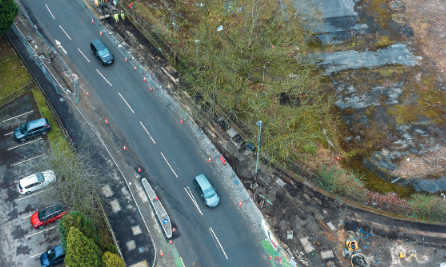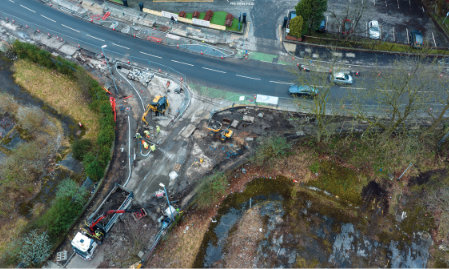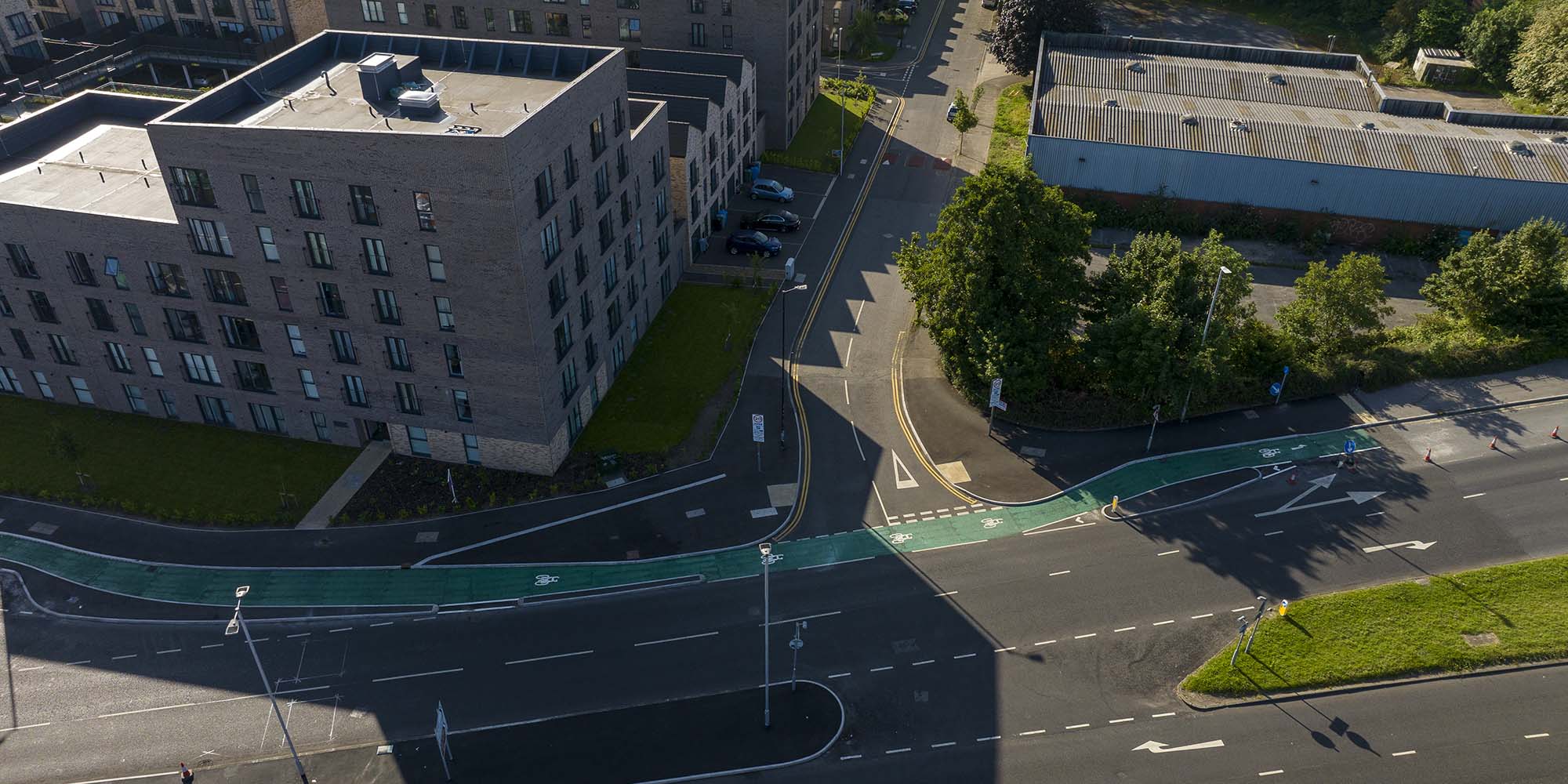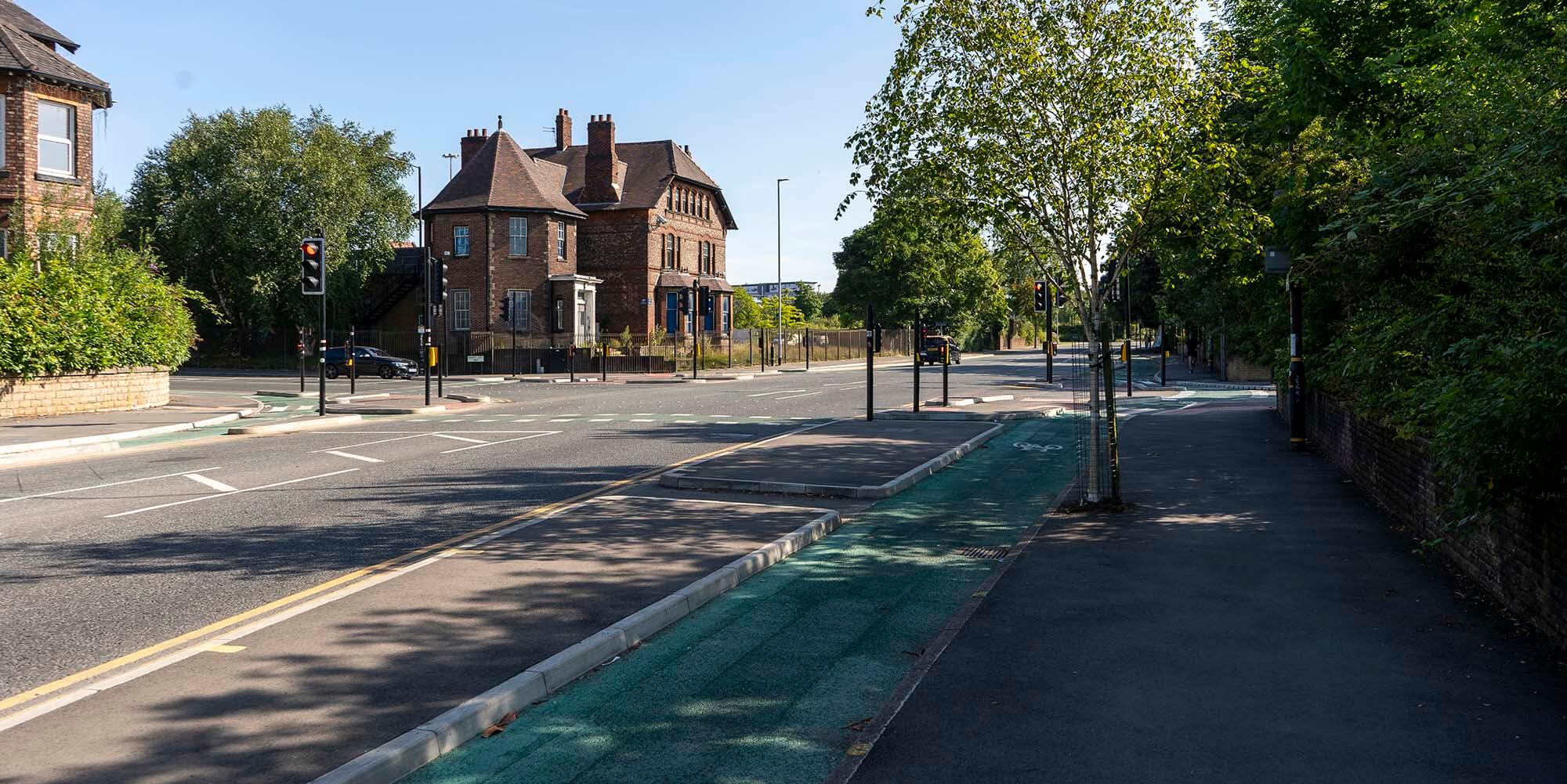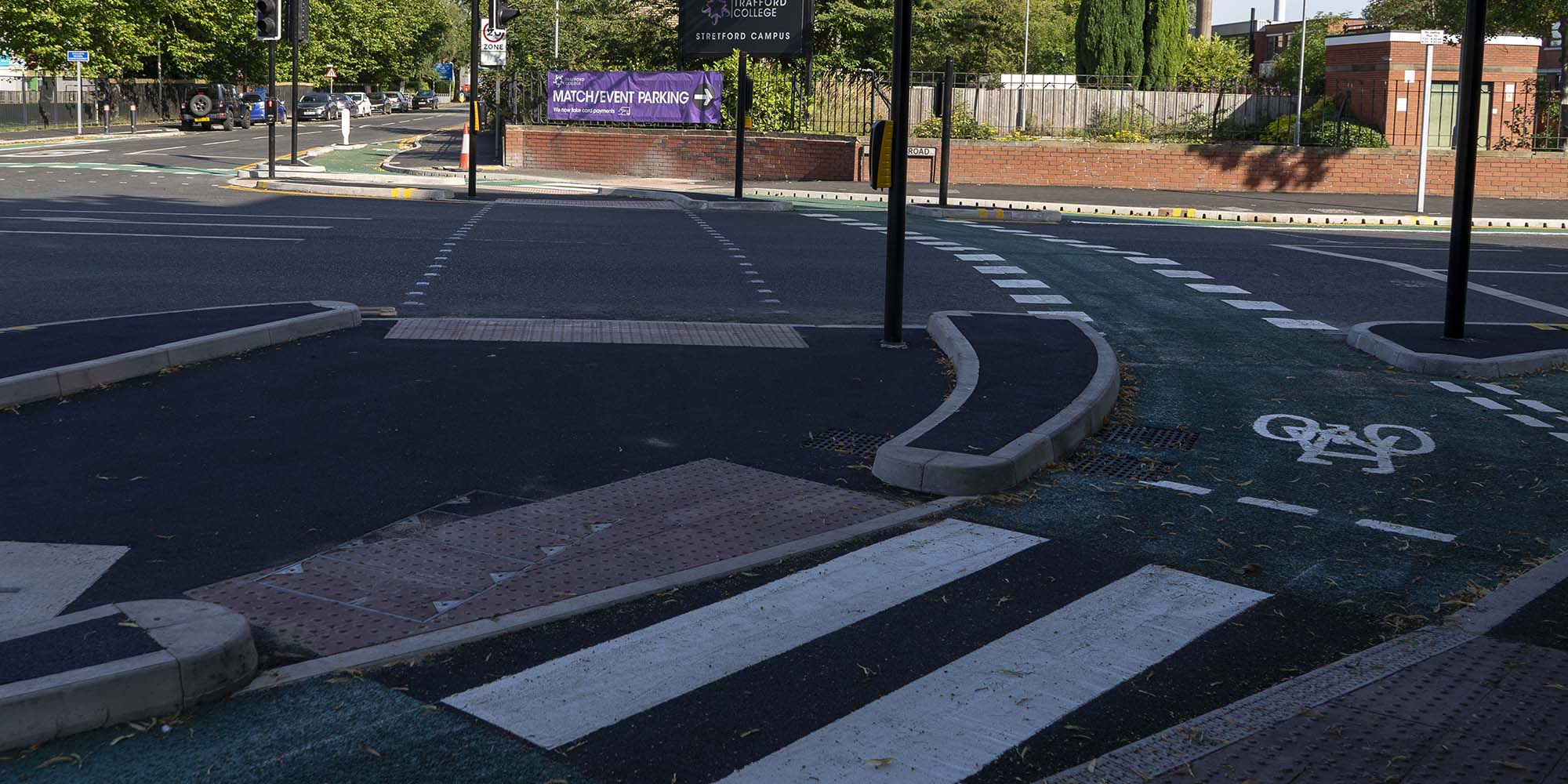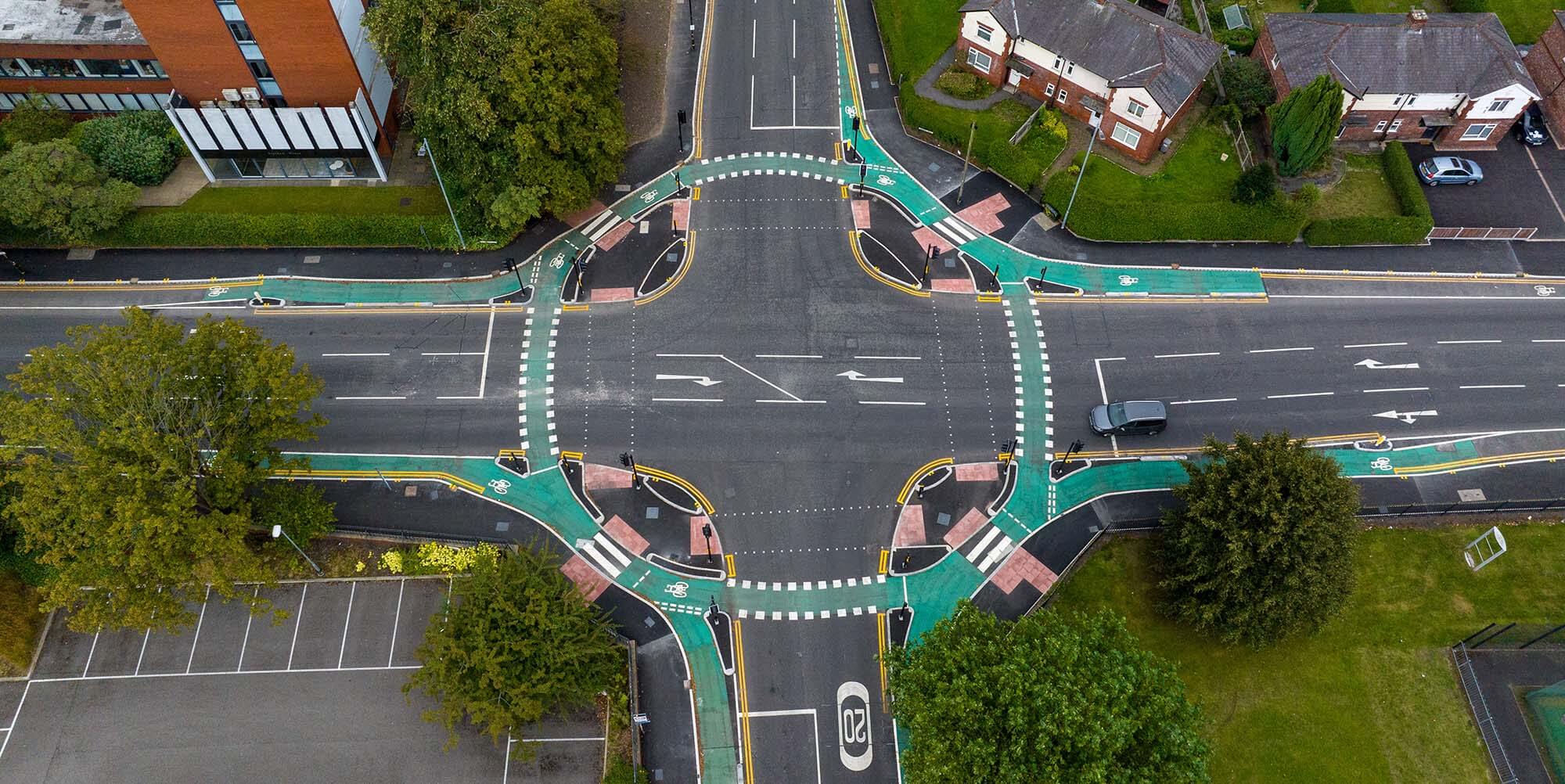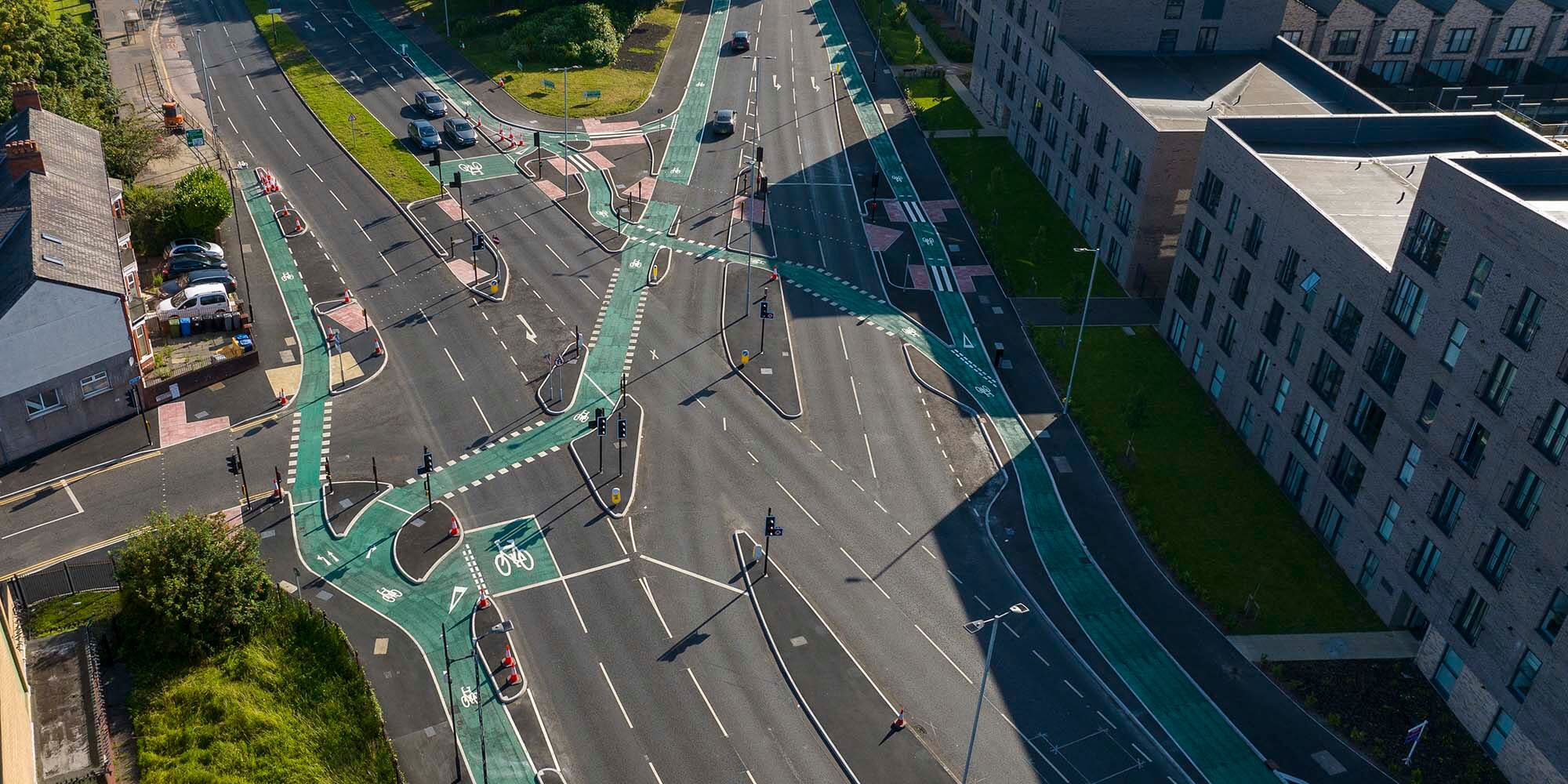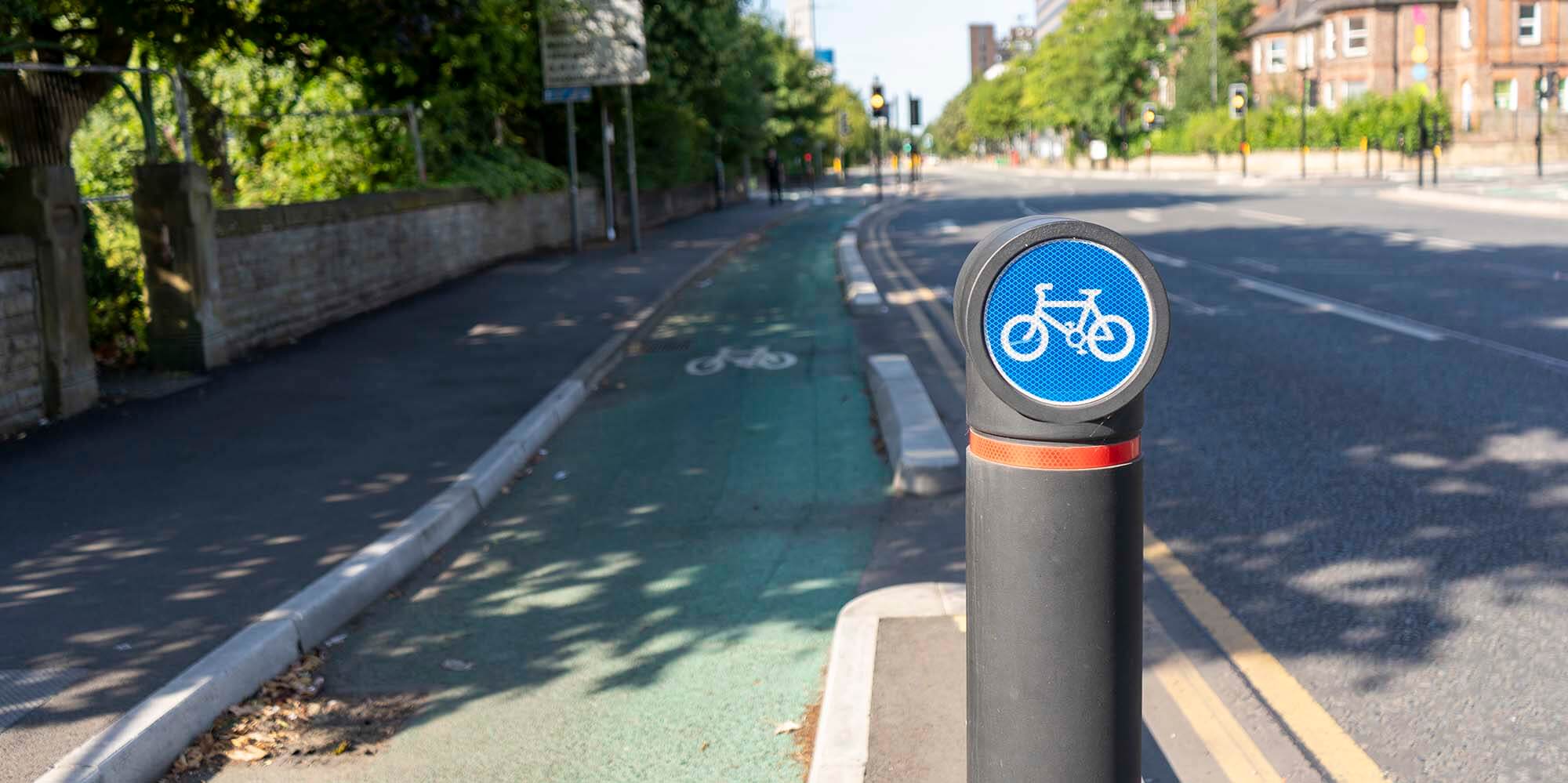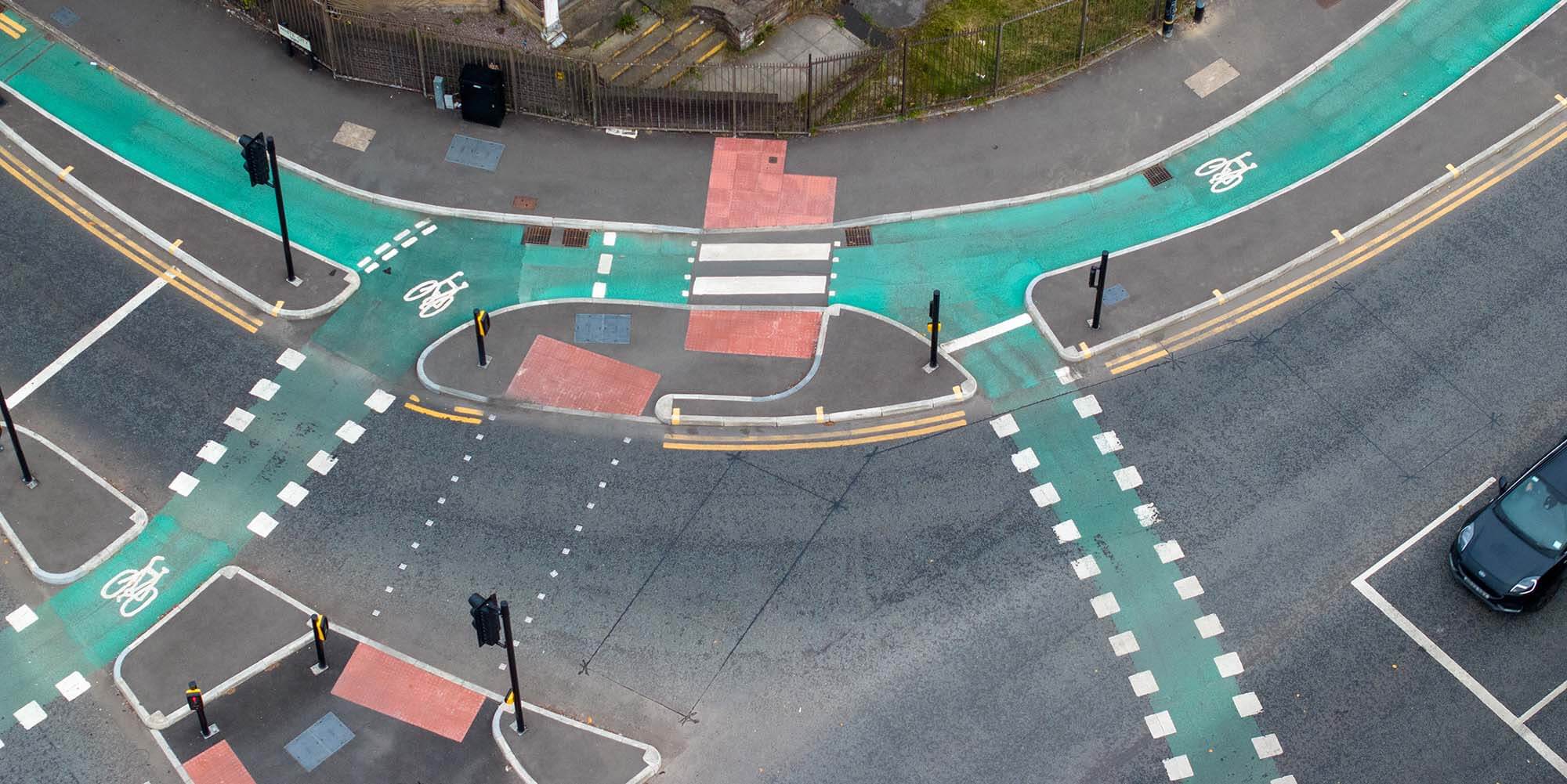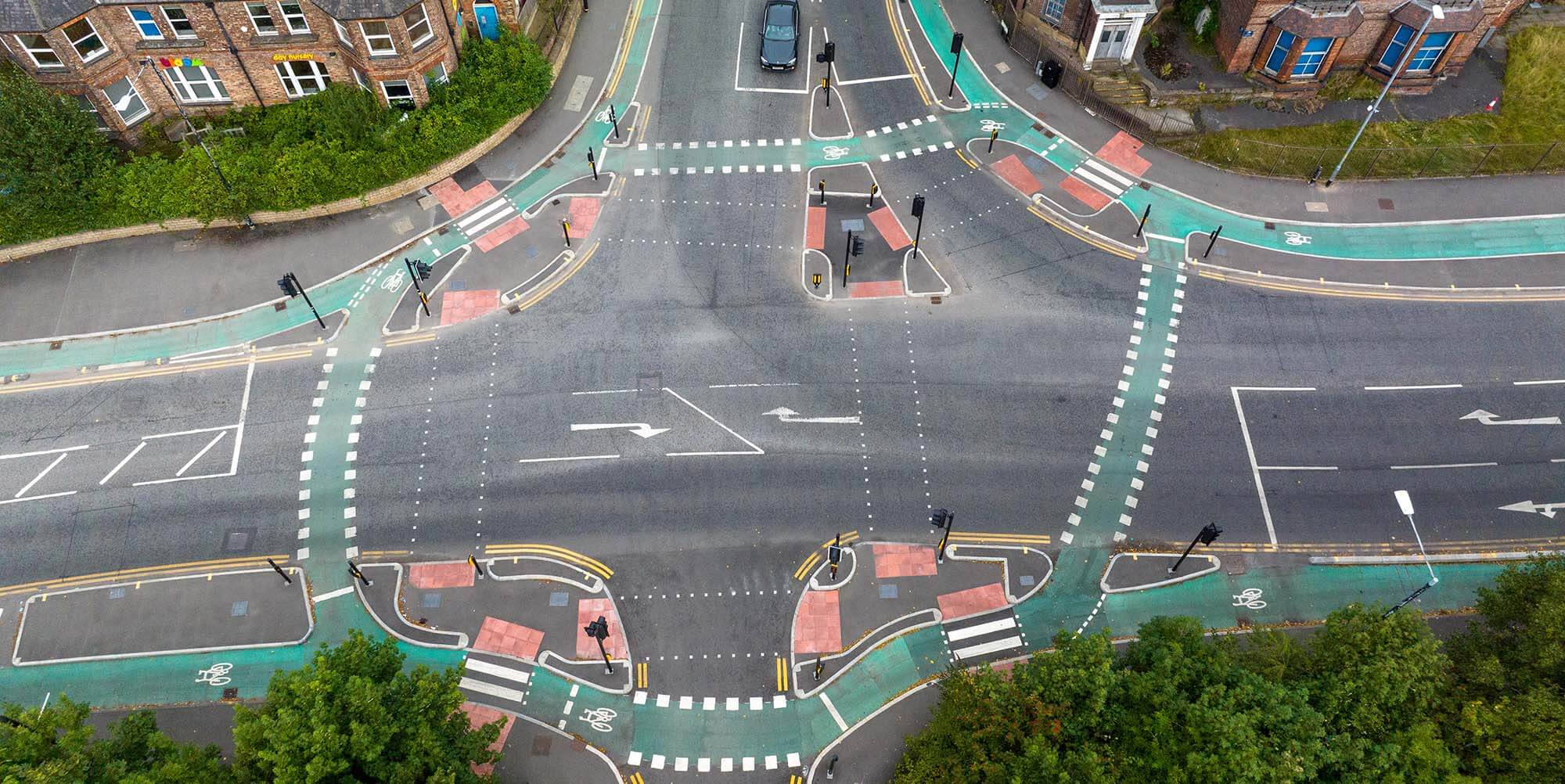Key to the successful role of the Bee Network Cycling Route in Trafford, which runs from the Trafford Bar Metrolink stop to the heart of Stretford, was the upgrading of three major junctions along Talbot Road. The need to provide safe continuous cycling routes across these junctions, whilst balancing the needs of pedestrians, cyclists and motorists was a principal challenge for the project.
The work forms part of Trafford Council’s plan for a North Active Travel Corridor offering residents, commuters and visitors alike the option to ditch the car and travel in a sustainable way. This is in line with Trafford Council’s ambitious Walking, Cycling and Wheeling Strategy, which aims to allow 90% of all journeys under one mile to be made on foot, bike or using wheeled transport.
Talbot Road is extremely busy and splits Trafford along the centre making it unavoidable for local cyclists but without protection few want to risk it. The three junction improvements provided the creation of a safe continuous cycling and walking link through the centre of Trafford opening the area up for active travel, improving safety and taking cars off the road.
This was the first project Trafford Council had undertaken with the Mayors Challenge Fund, and there were exceptionally sensitive locations involved. The client was unfamiliar with a truly collaborative approach and repeatedly expressed surprise at the level of support and flexibility we provided during pre-construction discussions. From multi-phase traffic management, including detailed proposals, to the identification of cost-saving opportunities such as remodelling levels to significantly reduce regulating costs, our approach was comprehensive.
During construction, several challenges and obstacles arose, particularly concerning the existing services. Despite thorough service details and planned diversions, numerous unexpected and shallow services were encountered during excavation. This led to delays as the team had to negotiate how to safely construct over these shallow services and modify designs where lowering or diverting them was not feasible.
Managing traffic presented another significant challenge due to the project’s location on busy roads with complex four-way junctions. Maintaining traffic flow was critical and required careful planning and coordination. On Chester Road, the team implemented road closures for surfacing work exclusively at night to minimise disruption. At all other times, the junctions remained open to traffic.
Managing pedestrian safety, along with cyclists and electric scooter users, added additional difficulties due to high foot traffic in the area. Ensuring users adhered to designated diversion routes proved challenging, necessitating the implementation of extra procedures and safety measures. The busy site demanded constant vigilance to ensure safe passage for all non-motorised users.
Further complications emerged during the work on Chester Road and Great Stone Road, where a reinforced concrete slab in the top layer of the carriageway was found. The process of breaking out this slab for drainage and kerb installation took three times longer than initially anticipated. This unexpected delay required the project team to reallocate resources and extend the timeline for these specific tasks, further complicating the overall schedule.
The proximity of the work sites to Old Trafford’s cricket and football grounds also added a layer of complexity to the project. During events and concerts, the area experienced high peak traffic flows, requiring careful planning and adjustments to programme, to avoid congestion. This often meant pausing or altering construction activities during peak times to ensure continuous traffic flow.
Close collaboration with TfGM and key stakeholders was crucial to keeping the project on track. Regular communication ensured alignment and efficient progress.
Directly engaging with their Communications Team and Social Value Coordinator helped establish positive lines of communication from the outset. Monthly newsletter updates were published to provide residents and businesses with the latest information on the project’s progress and any upcoming works that might affect them. In addition, letter drops were conducted.
Our social value contributions equated to an additional 30% of the final contract value, which was given back to the community, making a meaningful impact. This was recorded through the Social Value Portal, which also reached out to us to showcase our work as a case study of good practice. Some of our initiatives included:
- Our team visited the Little Green Sock Project, who provide help to local children living in poverty.
- Our Graduate Quantity Surveyor, Kevin Blackman, attended numerous school events initiated by Our Futures, which aimed to inspire students about the importance of business concepts and prepare them for future job interviews.
- Volunteering with Stretford in Bloom, where our team prepared community spaces and created planting areas to bring vibrant greenery to the streets of Stretford.
- At Stretford Public Hall, we removed some parking spaces, increased cycle parking, and created new SUDS/planted areas with tree planting to transform the space into a more multifunctional outdoor area for events. We also used this project as a training exercise for our apprentices, further enhancing the experience.
- At Blessed St. Thomas School, we made disability access adaptations, including ramps and door access improvements, to better support wheelchair users, including pupils.
Leaders from Trafford Council were recently joined by officers from South Yorkshire Combined Authority and active travel officers from across Greater Manchester to celebrate the opening of the junctions. The group were completing a cycle route from Manchester via Trafford and Salford, to learn more about the active travel schemes in the area.
The scheme received positive feedback from local councillors and TfGM. Our collaboration with Amey and Trafford Council was highly successful, especially for a first project together. Strong communication and a solid working relationship ensured efficient, cost-effective completion and quick issue resolution.
Project Updates
Works have now started on the latest phase of Trafford Council’s programme of constructing cyclops junctions along the A56 Chester Road and Talbot Road. The junction improvements will see the creation of a safe continuous cycling and walking link through to the centre of Trafford, opening the area up for active travel, improving safety and taking cars off the road.
This phase will see the junctions of Talbot Rd/Chester Rd and Talbot Rd/Seymour Rd undergoing major reconfiguration into cycle friendly links and cyclops junctions, including smart signals to cut down on unnecessary waiting. Talbot Road is a very busy road and well used by local cyclists, these works will make it easier and safer to use and hopefully make active travel more appealing to less confident members of the
community.
Works are programmed to be completed by Christmas 2025.
December 2024
Works started on the 11th November and paused for the Christmas shut-down on 20th December.
The first area to be constructed is the cycleway to the southern footpath between the end of the recently completed work at White City Way junction, towards Seymour Road. To date we have installed the new footpath kerb and laid the initial bitmac surface. This enabled us to re-open the footpath for pedestrians over Christmas.
We’ve also installed some of the new cycleway islands but these works have had to be halted until the underground services have been diverted.
January 2025
Works recommenced on Monday 6th January with the excavation of the trench for the newly diverted electricity cables. There will also be some more work on the cycleway islands and start the reconfiguration of the junction of Boyer St.

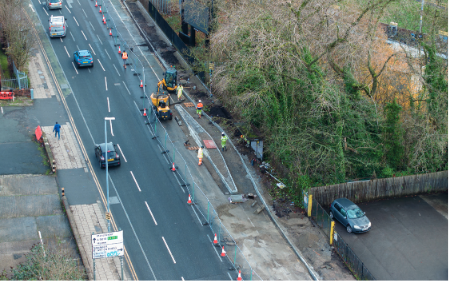
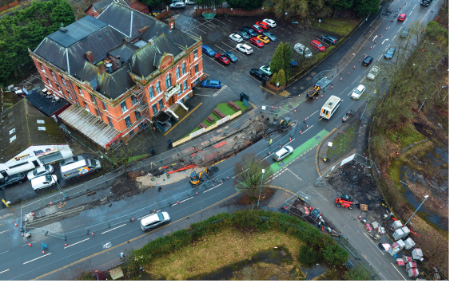
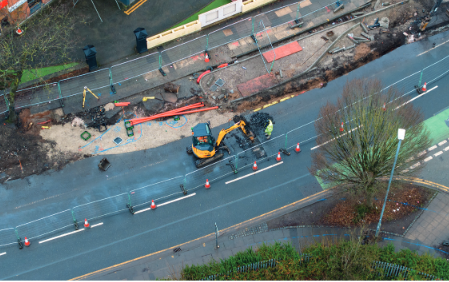
January 2025
Work recommenced on Monday, January 6th, with the excavation of a trench for the new diverted electricity cables. However, this has proven to be particularly challenging due to the presence of old tram tracks, reinforced concrete slabs beneath the road surface, and the unexpected discovery of a shallow, abandoned railway tunnel. These complications have slowed progress, but work is continuing.
Despite these challenges, we have made some progress on the cycleway islands and the proposed pedestrian crossing. However, these elements cannot be fully completed until the electricity cables have been relocated.
February 2025
Once the cables have been moved, we will proceed with the installation of the new drainage system along the southern footway. Following this, we will complete the remaining work on the cycleway before shifting focus to the north side of the site.
February 2025
The HV electric cables were finally diverted at the beginning of the month, however, to avoid delays, the works on the southern footway have been postponed and work swapped to the northern side, either side of Boyer St. Because of the lane closure on the north side, we are not able to complete the work to the southern side but will return once the traffic management is out of the way.
Works on the north side have also required diversions to some services but this was done without too much fuss and work continued with the realignment of the kerb line, reconstruction of the footways and construction of the cycle segregation islands.
March 2025
We are currently working in Areas 4, 5 and 6 (the junction of Boyer St and footways either side) and works are progressing well. We continue to install the new kerb line and reconstruct the footway to binder course. Once the new street lighting has been installed the footways can have the final surface course.
We have uncovered an old manhole on the line of a drain that runs down Boyer St, which would appear to have been blocked for several years. Work is ongoing to clear the drain of silt and then we will survey it to see if it is useable or if there has been a collapse further down the line.
